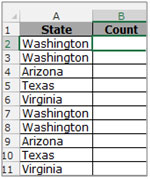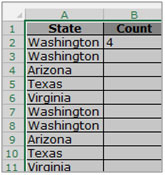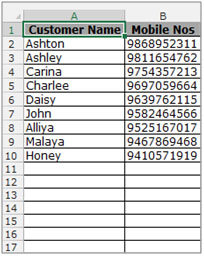In this article we will learn about how to prevent duplicates while entering the data in Microsoft Excel 2010. We can use Countif formula to prevent the duplicates entry.
COUNTIF: - By using this formula you can identify the duplicate entries in a data and can capture duplicate entries in a range.
Syntax of “COUNTIF” function: =COUNTIF (range,criteria)
Example:-

We have table in range A2:A11, in which needs to count of states that how many times states are repeating in Column A.

Let’s take an example to understand how and where we can prevent the duplicate entries.
We have a data of Mobile nos. In which we want to stop the duplicate entries of mobile numbers.

To preventing duplicates while entering in the data follow below given steps:-



This is the way you can restrict the duplicate entries in a data by using the Data Validation option in Microsoft Excel 2010 and 2013.
The applications/code on this site are distributed as is and without warranties or liability. In no event shall the owner of the copyrights, or the authors of the applications/code be liable for any loss of profit, any problems or any damage resulting from the use or evaluation of the applications/code.
HOW CAN I MANAGE WITH TWO COLUMN
I FOLLOWED ALL THE STEPS AND FOR SOME UNKNOWN REASON IT DOES NOT WORK. I TRIED BOTH FORMULAS =COUNTIF(B:B,B1)=1 and =COUNTIF(B2:B500,B2)=1 THE SYSTEM STILL ALLOWS ME TO ENTER DUPLICATE ENTRIES.
PLEASE HELP!
Hi Trish,
Make sure that the "Show error alert after invalid data is entered" is checked! If that is not checked, you would be able to enter duplicate entries.
Also, in case you are trying to copy and paste the value from some other cell or drag the formula to the data validation cell, then too it will not prevent any duplicate entries. For that, we have to first protect the workbook.
We hope it works for you know and in case if you still see any error, please feel free to write us back.
Best Regards,
Site Admin
TThe problem is that this works only if you input the numbers from the keyboard,if you copy past it dosent work
"You need to type the message that is in the following brackets:
""The value you entered already appears in the list""
This is the message that will pop up when a duplicate is found. "
"I am running Excel 2001 for the MAC.
I don't understand what I am supposed to put in the Error message Box. "" in the Error msg box enter the value you entered already appears in the list"" "
"I found this tip very useful and I have shared this with all my colleagues.
Keep up the good work.
I am an excel enthusiast myself and would like to share my knowledge too."
How do you sort the column with the duplicate error message? Can the column be sorted in ascending order? I want all the messages with duplicate to be together and same with the unique messages. I'm not getting that.